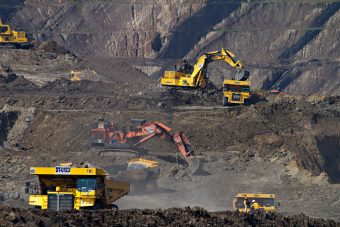
The Balkan Peninsula is an area that has significant deposits of coal, especially lignite, known as brown coal. Serbia has the most extensive coal deposits in the Balkans and ranks high for lignite deposits globally – right after Germany, Australia, the United States, Russia, and some other countries. The majority of Serbian coal mines are located in the Kolubara and Kostolac basins. Kosovo is also very rich in lignite and it ranks highly in terms of its quantities, but also its use. The key coal mines in Bosnia and Herzegovina are located in Tuzla, Banovići, Breza, Kakanj, Zenica, Bugojno and Gacko. North Macedonia has lignite reserves concentrated mainly around the towns of Bitola and Oslome. Countries in our region are faced with striking a balance between their current dependence on coal and the need to transition to cleaner energy sources. We have been working on this every year, especially under the influence and with the help of the EU.
As for Europe, the continent experienced a few upheavals, especially between 2018 and 2020. In 2020, Europe consumed about 246 million tonnes of brown coal. This was 33 percent less than in 2018 and 64 percent less than in 1990. Overall, in the thirty years between 1990 and 2020, coal production fell by 80 percent, according to Eurostat data.
The Balkan countries are trying to follow, to a greater or lesser extent, the EU agenda when it comes to RES. They have also signed a relevant contract because the Balkans is invited to reduce their heavy dependence on coal, as a limited resource and the biggest polluter. The countries of the region have mostly decided to adhere to EU policies, which imply the implementation of all environmental protection regulations and measures to achieve the goal of reducing net carbon dioxide (CO2) emissions to zero by 2050 at the latest. However, no matter how attractive RES are, this still poses a challenge to the Balkan countries particularly in terms of finances and steady operation of power plants.
More:
- WHY IS THE DESULFURIZATION SYSTEM AT TENT IMPORTANT FOR SERBIA?
- GLOBAL COAL DEMAND IS SET TO RETURN TO ITS ALL-TIME HIGH IN 2022

With coal-fired thermal power plants, it will not be possible to reach carbon neutrality for half a century. Countries often failed to meet the agreement stipulations all these years and emitted many more harmful gases than the allowed limits, such as sulfur dioxide which was several times higher than allowed. Gacko, Ugljevik, Kakanj and Tuzla mines were some of the biggest polluters in the past few years. Meanwhile, more money has been invested in various advanced equipment to bring the Western Balkan energy route closer to the EU.
The below data from the last 12 months show how active coal was in the production of electricity in regional countries.
In Serbia, 39.85 percent of electricity was obtained from coal in the last 12 months, considering that our thermal power plants mainly use lignite, but also a significant share of 39.27 percent comes from hydro-energy in the same period.
Croatia, just like Serbia, generates large quantities of electricity from hydro-energy – 45.06 percent – which is not surprising. After that, wind energy ranks high at 13.64 percent and gas at 12.55 percent, which also produces the largest share of emissions, while coal was close to zero.
In Bosnia, hydro-energy and coal have the highest share in electricity production with 44.8 percent and 42.32 percent respectively. North Macedonia also predominantly uses coal (38.22 percent). Slovenia, for example, uses 29 percent of nuclear energy, as much as hydro energy, while 5 percent is coal. In a number of other European countries, coal is not used at all, or very little, like in Croatia. In countries which do use it, there is a plan to shut down coal-fired plants or switch them to use other forms of energy by 2030. Poland is one of the countries most dependent on coal, despite being an EU member.
Earlier reports from European agencies warned that the Balkans is a problem spot in terms of air and water quality, which strongly affects the surrounding countries. Pollution from coal-fired power plants in the Western Balkans also has a cross-border impact, despite the air being cleaner in Western Europe. According to WHO data from last year, Bosnia and Herzegovina had the fifth-highest death rate as a result of air pollution, due to excessive use of poor-quality coal.

Eastern Europe, especially the Balkan countries, is struggling with an air pollution crisis that is in stark contrast to the air quality in Western Europe. Looking back at the said information, the pollution data paints a poor picture but coincides with the coal data. Reliance on coal mining and the proliferation of lignite-fired power plants has resulted in alarming levels of air pollution. A striking indicator is that of the 50 most polluted cities in Europe, in 2022, nineteen are located in Bosnia and Herzegovina, and 12 in Serbia. Herceg Novi in Montenegro and Tuzla in Bosnia and Herzegovina are among the most polluted towns.
While Western Europe generally meets the World Health Organization’s pollution guidelines, the entire population of Eastern Europe lives in conditions that are unfavourable to their health. Eastern Europeans lose an average of 10.7 months of life to pollution, compared to just 3.8 months in the West, according to research by the University of Chicago’s Energy Policy Institute.
This region is peculiar because it resembles a labyrinth from which it is difficult to get out – there is a lot of lignite, the mines are brimming with it, and it is a cheap and easily usable source of energy, but it also promotes serious pollution and is dangerous for the population’s health.
Western Europe, in contrast, has seen notable improvements in air quality over the past two decades. Portugal, for instance, implemented all WHO clean air guidelines. This division within Europe not only underscores the urgent need for Eastern Europe to end its excessive use of coal but also the necessity of collective, strategic action.
Milica Vučković



